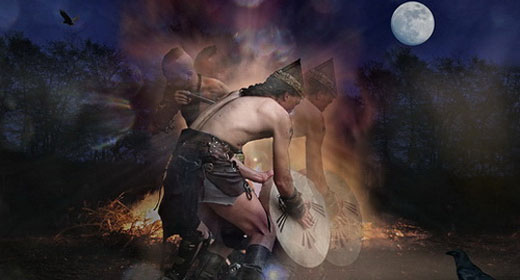by Dr. Alberto Villoldo: From earliest times, humankind has expressed its reverence for the natural world by using animals as totems and symbols of the highest ideals…
The earth’s fauna have been used to express the strength of rulers (the lion), the purity of God (the lamb), and the sacred principles of the universe (the serpent and the eagle). The Toltecs and other Meso-American societies worshiped the winged serpent Quetzalcoatl, a god who was master of the winds and the sky, and the protector of his people. In Greek mythology, Medusa’s scalp writhed with live snakes, symbolic of her sovereign female wisdom (but one glance at her was said to turn a man to stone), while the hero Hercules was often portrayed wearing a lion skin, which gave him the beast’s cunning, strength, and dominance over the animal world.
Religious lore is filled with animal references as well—in the Bible, King Solomon is referred to as the “lion of Judea,” and Jesus is called the “lamb of God.” In the Hindu religion, cows are held to be sacred; and there are animal gods such as Hanuman, the monkey god; and Ganesh, the elephant god. The zodiac and the Chinese calendar also have many animals as its symbols.
Cultural identifications with animals are so strong that entire civilizations have taken them as their symbols. For example, the mighty lion, a symbol of courage, has long represented England; and the industrious honeybee, a symbol of immortality and resurrection, was chosen as an emblem by both Charlemagne and Napoleon to represent France.
Perhaps the most omnipresent animal symbol of all has been the eagle—adopted by both ancient and modern cultures around the world. This magnificent bird has been associated with the Greeks, Egyptians, Sumerians, Hittites, and Romans, all of whom used it as an emblem for their formidable empires. The bald eagle was also chosen to represent the might and freedom of the United States.
While in our Western culture we behave as though all of nature is ours to subjugate at our will—after all, in the first book of the Bible, humans were given every creature on the planet—most indigenous cultures still live in harmony with animals. As with all Native American peoples, the Laika understand themselves to be the caretakers of all life, and they strive to live in harmony with nature and to communicate directly with it. Indigenous Americans have many traditional animal dances (such as those of the snake, eagle, and deer), in which participants wear the skins of the animals to embody their spirits so that they’ll be able to move more easily in their world during the hunt or through journeying. By summoning the spirit of that animal, they embody its essence, and by wearing their fur or feathers they are empowered by its attributes.
When an Osage Indian dancer put on a buffalo headdress, it was to ask permission to take the life of a buffalo, in the hopes that the animal would be renewed with life the following year. The Osage didn’t seek to exterminate the buffalo—they honored it and respected its awesome powers. They understood that they could just as easily be trampled to death by these magnificent beasts as they could succeed in taking one during the hunt.
By living with respect for nature, becoming part of its cyclical character, and understanding their place in it, the Osage took only what they needed for food, and in turn, their resources were renewed over and over again. Nothing could have been in greater contrast to this than the arrival of the white man in the American West in the 18th and 19th centuries: They shot buffalo for profit and sport and slaughtered millions of animals, bringing about the demise of the great herds and hastening the end of the natural lifestyle of many indigenous tribes.
These days, in our commercially oriented culture, animal imagery is often used in advertising or as a business logo because we intuitively respond to the meaning of each animal’s attributes. We know what the jaguar means when it comes to a sports car—it will be sleek, fast, and elite, just as this animal is one of the swiftest and most revered of the jungle. Dodge’s best-selling truck is called the Ram to imply that it is sure-footed on rocky terrain.
But apart from archetypal images used in advertising, most of us have lost our sense of connectedness to all but the most domesticated of animals. Our only contact with wild animals is through watching them on television or observing them in cages at the zoo.
Next week we’ll examine the four most important spirit animals of the Laika.









































